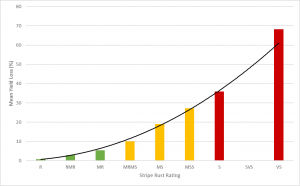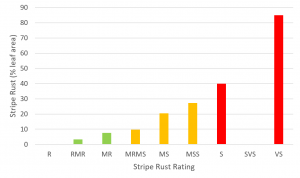Genetic resistance in varieties provides cheap and effective disease management options and reduces reliance on fungicides. All field crop cultivars are independently rated for their resistance/susceptibility to important diseases. Resistance ratings are updated annually and published in regional disease guides for cereals, pulses and oilseeds.
Understanding the resistance/susceptibility to diseases is important for growers when selecting cultivars and effectively planning their disease management strategies.
This chapter explains disease resistance ratings, how they are generated and how disease ratings can be used to inform disease management plans.
What do they mean?
Disease ratings describe how much or little disease a variety is likely to endure during seasons conducive to disease development when the pathogen is present. Disease is unlikely to develop within crops when the season is not suitable for disease development or the pathogen is not present; hence even highly susceptible cultivars may be disease free in some seasons.
Field crop varieties are rated for their disease reaction using a nine-point scale ranging from Resistant (R) through to Very Susceptible (VS). These ratings describe the level of genetic resistance present in a cultivar to each disease. A variety rated as Resistant will typically show no symptoms of disease, while those rated as Very Susceptible can suffer large damage when the disease is present.
All ratings between these two extremes have some resistance that slows disease progression to different degrees. That is, even cultivars with a Susceptible (S) rating have some resistance when compared to cultivars with a Very Susceptible rating.
The relationship between disease rating and leaf area affected with stripe rust is shown below.
This shows that as a variety’s rating increases, the leaf area affected with stripe rust also increases. How much disease is present in any cultivar in any given season is also influenced by the inoculum present and the seasonal conditions. Equally the disease rating relates to the relative yield loss cultivars are likely to suffer in the presence of disease when conditions are conducive for yield loss.

Relationship between resistance rating and yield loss caused by stripe rust using data collected from six locations across south eastern Australia during 2005 (yield data courtesy of AGT).
How are Ratings Developed?
Disease ratings in Australia are developed by plant pathologists in a nationally co-ordinated program of both field and controlled environment testing. The work is funded by the GRDC through its NVT program with the work undertaken by specialist plant pathologists across Australia. Advanced breeding lines that are submitted to the NVT for yield evaluation and a large range of important commercial varieties are independently tested for a range of important diseases.
Within each experiment the test lines are exposed to a high disease pressure to enable assignment of a disease ratings. The lines are then assessed for disease severity by an experienced research scientist. The disease severity data from a single experiment is then combined with data collected in different environments and seasons and then a disease resistance rating using the nine-point scale, from Resistant to Very Susceptible (Table 2.1) is then assigned. The ratings are developed in collaboration with multiple researchers and then published in regional disease guides for each state and on the NVT website.
Ratings of cereal and pulse varietal resistance and what they mean. Current as of May 2020.
| Disease Rating | Symbol | Description of Cereal Ratings | Description of Pulse Ratings |
|---|---|---|---|
| Resistant | R | Disease symptoms may be found at very low levels following close crop inspection. Generally, no management is required even in instances of high disease pressure. Monitor crops for breakdown in resistance. | Resistant - No symptoms visible. No fungicides are required. |
| Resistant – Moderately Resistant | RMR | Disease symptoms may be found at low levels following close crop inspection. Generally, no management decisions will be required. Monitor crops for breakdown in resistance. | Resistant to Moderately Resistant - The disease may be visible but will not cause significant plant damage or loss. However, under extreme disease pressure or highly favourable environments conditions fungicide applications may be required e.g. to prevent seed staining. |
| Moderately Resistant | MR | Disease symptoms may be observed, but generally no management decisions will be required. However, under severe disease pressure active management may be necessary. Monitor crops for disease. | Moderately Resistant - The disease may be visible but will not cause significant plant damage or loss. However, under high disease pressure or highly favourable environments conditions fungicide applications may be required e.g. to prevent seed staining. |
| Moderately Resistant – Moderately Susceptible | MRMS | Disease symptoms may be observed, but generally no management decisions will be required. | Moderately Resistant to Moderately Susceptible - The disease symptoms are moderate and may cause some yield and/or seed quality losses in conducive conditions. Fungicide applications, if applicable, may be required to prevent yield loss and seed staining. |
| Moderately Susceptible | MS | In seasons conducive to disease, symptoms will be detected during crop inspections. If the disease appears early in the season, then preventative action may be necessary. Crop losses of 15 per cent or more can occur in severe cases. Monitor crops. | Moderately Susceptible - Disease symptoms are moderate to severe and will cause significant yield and seed quality loss in the absence of fungicides in conducive seasons, but not complete crop loss. |
| Moderately Susceptible – Susceptible | MSS | In seasons conducive to disease, symptoms will be detected during crop inspections. When varieties drop below this minimum level of resistance there can be a build-up of disease. Still a useful level of resistance. Management decisions could be required to reduce disease. Monitor crops regularly. | |
| Susceptible | S | Disease symptoms will be easily found during crop inspections. Management decisions will be required to reduce disease. Expect yield loss in the range of 15-50 per cent without management. Monitor crops regularly. | Susceptible - The disease is severe and will cause significant yield and seed quality loss, including complete crop loss in the absence of fungicides, in conducive conditions. |
| Susceptible – Very Susceptible | SVS | Disease symptoms will be easily found during crop inspections. Crop loss can be greater than 50 per cent in the absence of management. It is not recommended to grow varieties with low resistance if the disease is common to the area. Monitor crops regularly. | |
| Very Susceptible | VS | Disease symptoms will be easily found during crop inspections. The use of this resistance level is not recommended if the disease is common in an area, as there can be total crop loss. Active management with fungicides is not generally considered economic. | Very Susceptible - Growing this variety in areas where a disease is likely to be present is very high risk. Significant yield and seed quality losses, including complete crop loss can be expected without control and the increase in inoculum may create problems for other growers. |
Why Can a Variety Have a Different Rating in Different States?
Disease ratings reflect the strains of disease present in each region. Where a disease is known to have a similar virulence profile nationally (that is the same strain is across the country) then a nationally rating is applied. An example of this is yellow leaf spot in wheat.
However, where different stains of a disease are known to occur in different regions then regional ratings are applied. For example, the wheat stripe rust present in eastern Australia is different to that in Western Australia.
Therefore, for stripe rust wheat varieties are given an eastern and western rating (for example, the wheat cultivar Mace rated SVS in eastern Australia is rated as R in Western Australia). Not all cultivars will have a different stripe rust rating in the east vs the west, as it depends on the different resistance genes in cultivars.
Ongoing monitoring of pathogen strains present nationally is important in informing the rating assigned to cultivars. An example of on-going monitoring is the work of the Australian Cereal Rust Control Program at The University of Sydney where the cereal rusts present nationally are monitored.
Why do Ratings Change?
Disease ratings do change over time. This can occur when a pathogen becomes more virulent (also known as resistance breakdown) making a previously resistant cultivar more susceptible.
This change can be due to mutation or sexual recombination within the pathogen population or introduction of a new more virulent strain from another region or another country. Since resistance ratings are known to change it is also important to always consult a current disease guide.




